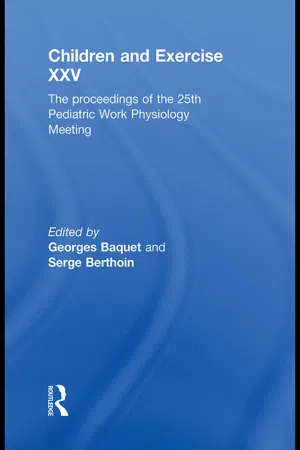
Children and Exercise XXV
The proceedings of the 25th Pediatric Work Physiology Meeting
- 260 pages
- English
- ePUB (mobile friendly)
- Available on iOS & Android
Children and Exercise XXV
The proceedings of the 25th Pediatric Work Physiology Meeting
About This Book
Children and Exercise XXV presents the latest research in the field of paediatric exercise sciences, focusing on the interaction between physical activity, exercise or sport on the one hand, and nutrition, metabolism regulation, cardio-respiratory function or muscle function on the other.
Including contributions from leading international experts, the book is arranged into six thematic sections addressing:
• metabolic syndrome and nutrition
• hormonal and inflammatory regulations
• cardio-respiratory function
• children's performance
• fitness assessment
• physical activity.
Offering a critical review of current topics and reports of contemporary research, this is a key text for all researchers, teachers, health professionals and students with an interest in paediatric sport and exercise science, sports medicine and physical education.
The papers contained within this volume were first presented at the twenty-fifth Paediatric Work Physiology meeting, held in Le Touquet, France, in September 2009.
Frequently asked questions
Information
Part I
Keynote Lectures
CHAPTER NUMBER 1
The 2009 Josef Rutenfranz Lecture “Child as a Source of Mechanical Power”
Blaise Pascal University, Clermont-Ferrand, France
1.1 INTRODUCTION
1.2 AGE-RELATED DECLINE IN PHYSICAL ACTIVITY?
1.3 SHORT-TERM EXERCISE OR LONG-TERM EXERCISE?

1.4 HOW TO MEASURE ‘ANEROBIC FITNESS’ DURING GROWTH?
1.4.1 Invasive methods
1.4.2 Non-invasive method: 31P-NMRS
1.4.3 Wilkie’s statement
1.4.4 Short-term mechanical power output during growth
1.5 WHAT ARE THE MAIN BIOLOGICAL DETERMINANTS?
1.6 CONCLUSION
1.7 REFERENCES
Table of contents
- Contents
- Preface
- Acknowledgments
- Acknowledgments
- Acknowledgments
- Acknowledgments
- Part I Keynote Lectures
- Part II Metabolic Syndrome and Nutrition
- Part III Hormonal and Inflammatory Regulations
- Part IV Cardiorespiratory Functions
- Part V Children’s Performances
- Part VI Fitness Assessment
- Part VII Physical Activity
- Correspondence Addresses
- Author Index
- General Index